Connect the Dot Graphic Design
HSIP: Airport Way/Steese Expressway Reconstruction
Project No. 0002(385)/NFHWY00245
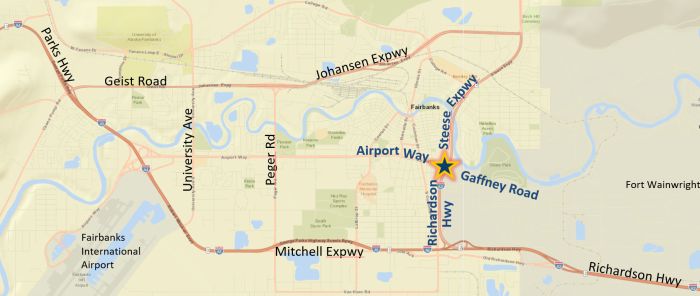
Intersection of Gaffney Road (to the east), Airport Way (to the west), Richardson Highway (to the south)
andSteese Expressway (to the north). We refer to this as the GARS intersection.
We are working on the final design of a project that will reduce congestion and improve safety at the intersection of Gaffney Road, Airport Way, Richardson Highway, and Steese Expressway (GARS) near the Fort Wainwright main gate in Fairbanks, Alaska.
The purpose of this project is to reduce the high number of crashes and improve current and future congestion, helping to get you through this busy intersection faster and more safely.
The existing intersection is regularly in the top 10 of all intersections in Fairbanks for total number of crashes within a five-year period. It has the fifth-highest number of total injury crashes. It's also Fairbanks' second busiest intersection, after Geist Road/Johansen Expressway, with 35,000 vehicles per day.
Proven Solutions, Innovative Design
We are moving forward with an innovative design that will keep traffic flowing through the entire area more smoothly than an overpass, is a relatively low-cost fix with no need for additional private property, will maintain access at 10th Avenue, and will retain more existing vegetation. Intersections like this have been proven to work in other snow states and we have a lot of features in the design to make sure you can navigate it easily, even in the winter.
Check out this video to get a breakdown of how the intersection will work:
Break It Down: the new Airport/Steese intersection from Alaska DOT&PF on Vimeo.
How does it work?
Here's a drawing of what the intersection will look like from above. We will have plenty of signs, medians, landscaping, lighting, and other features to make sure you'll know where to go when you're on the ground.
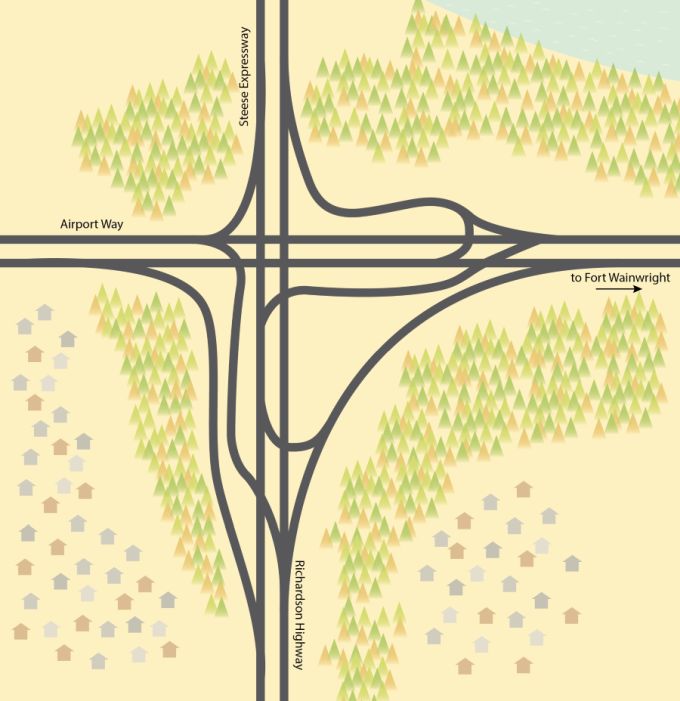
We know this looks complicated from above, so we're going to break it down for you. Let's start with straight-through traffic. If you are going straight through the intersection, you will still go straight through the intersection. It will be the same as it is now.
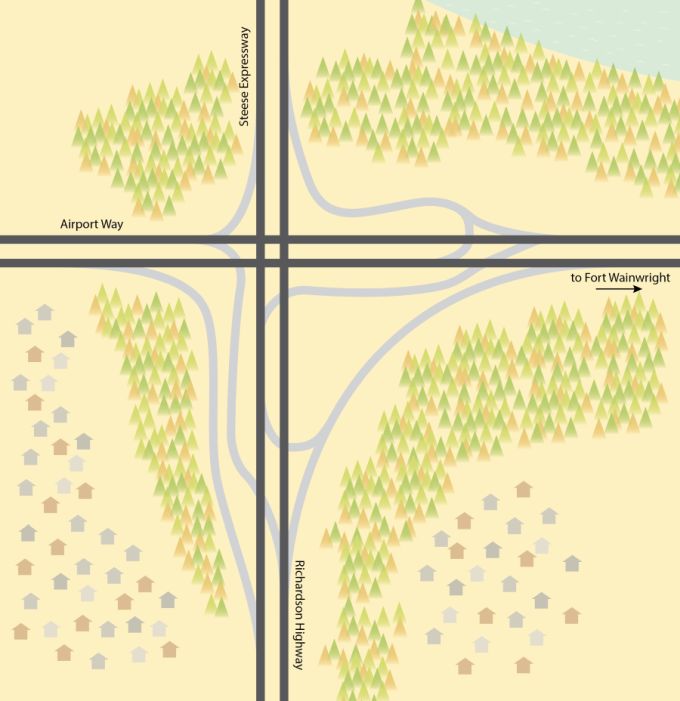
If you are turning right, you will turn right much the same as you do now. All right turns will be separated, just as most of them are separated in the current intersection.

The different thing about the new intersection will be left turns. We separated each left turn from the core intersection, because left turns are the cause of most crashes and they slow all the other traffic down. Removing them from the core intersection is a proven way to reduce crashes and improve traffic flow.
Two of the left turns will happen before the core intersection. These are called continuous flow left turns. These drivers will be directed, through robust signage, to left turn lanes and a traffic signal before the core intersection. First they will cross the traffic in the opposing lanes, then at another signal they will cross the traffic coming from the left. These signals will be synchronized so you should not have to stop at more than one. While these drivers are making their left turns separate from the core intersection, core traffic can continue to flow.
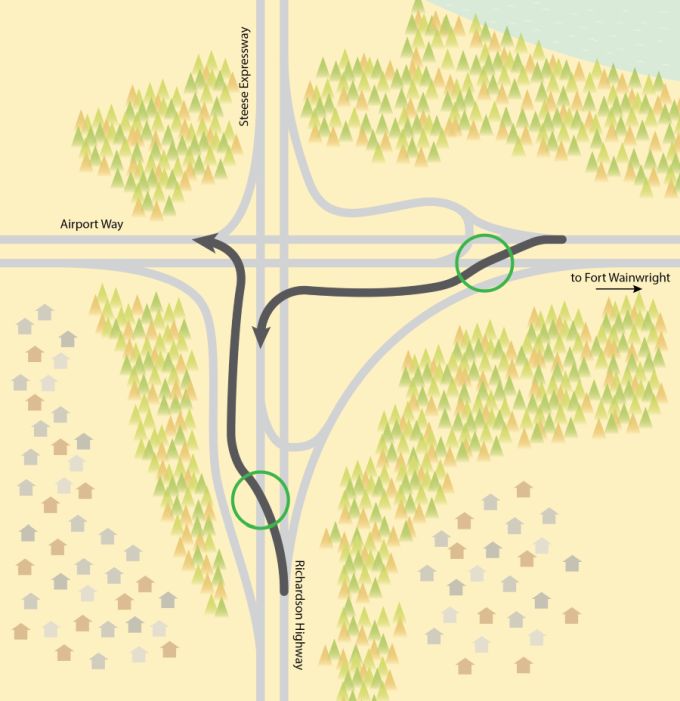
Check out this video to see what a left turn will look like for a driver heading northbound on the Richardson Highway, taking a left onto Airport Way before the core intersection.
GARS - Northbound Left Turn Lane.mp4 from Alaska DOT&PF on Vimeo.
Two of the left turns will happen after the core intersection. These are called median u-turn left turns. These drivers will go straight through the core intersection, cross opposing traffic at a signal, then swing back around to join through-traffic from the right lane. All the signals will be synchronized so you should not have to stop at more than one. The turn will be wide enough for a standard tractor trailer to navigate.

Check out this video to see what a left turn will look like for a driver heading southbound on the Steese Expressway, taking a left onto Gaffney Road toward Fort Wainwright after the core intersection.
GARS - Southbound Left Turn Lane from Alaska DOT&PF on Vimeo.
Do you still have questions about how you'll navigate the intersection? We're happy to talk with you any time! Reach out to us by email or call us at 907-451-5359.
Why change the left turns?
Most crashes happen at traditional four-leg intersections (like the current GARS intersection) when drivers are turning, especially when they are making left turns. There are many opportunities for conflicts when drivers are turning left including oncoming traffic, pedestrians at the crosswalk, and right-turning traffic from the oncoming lanes. The intersection that we will be constructing at GARS separates all the left turns so drivers only have to focus on one factor at a time. Separating left turns also allows core intersection traffic to continue flowing while drivers are crossing opposing lanes. The intersection will flow more safely and efficiently when we separate left turns.
Why not build an overpass?
Initially we looked into building an overpass but an overpass would be so expensive ($40-$50 million) that we weren't sure we would be able to fund it for many years, if at all. This project is being funded by the Federal Highway Safety Improvement Program, which has a limited budget. (This is not the same funding program that will pay for the project at the Steese/Johansen intersection, for example, so this project is under a different set of funding constraints.) The current GARS design costs about a third of an overpass—about $15 million.
Even better news, when we modeled this design and how it would move traffic through the intersection compared to the overpass, we realized that this design will actually function better than any other option. Unlike an overpass, it doesn't shut down left turns onto 10th Avenue and it is better for the nearby intersections because it meters the traffic better. An overpass design would have spilled traffic into the adjacent intersections at a high rate, causing them to be overwhelmed. With the overpass design, you would have been able to get through this intersection quickly, only to wait much longer at the intersections around it.
In other words, this option is the better than an overpass for not just cost, but also overall traffic flow. If we had all the money in the world to spend on this intersection, we would still choose our current design.
How will I know where to go?
Signs, medians, and landscaping will help you get where you need to go. Straight traffic and right-turning traffic will function similarly to the current intersection. All drivers, including those turning left, will see large overhead signs pointing down to the correct lane, medians with trees to guide you into the correct position, quiet rumble strips to alert you if you're out of the lane, and plenty of intersection lighting to help in the dark months.
Check out our video simulations to see how it will look driving through the intersection.
We will also be reaching out to the community with extensive public information to be sure drivers know what to expect when the intersections opens in 2023.
What will happen when it snows?
This intersection is the number one, first priority intersection in the Fairbanks area. This means it will always be the first spot our crews hit when a storm rolls in. Our Fairbanks maintenance team already has a plan in place for how to plow and clean this intersection. Wide shoulders and extra snow storage will also help this intersection stay in good shape during the winter months.
It is possible that the traffic striping on the road will be covered through some of our winter months, but the overhead signs, landscaping, and rumble strips will help guide you even if you can't see the stripes.
There are so many traffic signals—what happens if the power goes out?
The power at this intersection will be equipped with a battery back-up that will keep the signals and lights working during an outage. In the event of a long-term outage, we will be able to hook a generator up to the power source to ensure that all signals and lights remain active.
How will pedestrians get through the intersection?
Pedestrians will be able to navigate this intersection more safely and quickly, too! There will be fewer lanes of traffic to cross at a time and crossing times should be faster. This intersection will hook up with a bike path that we are planning to construct that will eventually connect North Pole to Fairbanks, which means we expect pedestrian crossings at this intersection will likely increase in the years to come.
This graphic shows how pedestrians will navigate the new intersection.
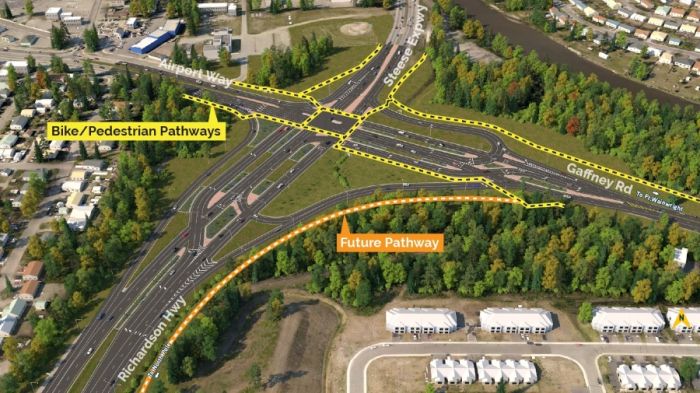
Construction
Construction on this project is expected to begin in 2022 and will be complete in 2023. During the first year of construction, most of the work will be done outside the existing driving lanes, so the impacts will be minimal. We don't expect any significant closures for this project, but we will be taking advantage of a planned two-week closure in 2022 that will occur for the Steese Expressway's Chena River Bridge re-decking project. During this closure, we will work on the north leg of the intersection.
This project is being developed in cooperation with the Alaska Division of the Federal Highway Administration. While developing this design concept we have also worked closely with Ft. Wainwright, the City of Fairbanks, Emergency Services personnel, the trucking industry and other community interest groups in Fairbanks to be sure their concerns were addressed.
If you have any comments for us, please feel free to reach out to the project manager, Carl Heim, P.E. Carl can be reached at carl.heim@alaska.gov or 907-451-5359.
Connect the Dot Graphic Design
Source: https://dot.alaska.gov/nreg/garsreconstruction/